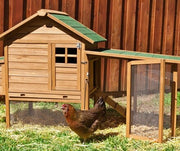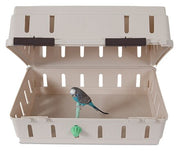Bird Toys with an Edge

The pet industry has certainly seen a lot of changes with pet toys in the last few years. Certainly, no one ever thought about guinea pig or rabbit or even hamster toys over a decade ago (except for the basics like the hamster wheel and exercise ball) and yet more and more toys are now being offered by manufacturers today. Of course, dog toys have been around for a very long time, and certainly rubber rings and balls along with the infamous ones like the vinyl pickle, rolled newspaper and porcupine that I played with in my father ’s store in the seventies are still being offered today. But some dog toys are now much more sophisticated with moving parts that make interesting sounds or will dispense a treat if moved in a certain way. Bird toys were actually the first to become more complicated because of birds, especially those in the parrot group, including parakeets and cockatiels, are extremely intelligent and need a lot of mental stimulation to keep them healthy and active.
FROM SIMPLE TO SOPHISTICATED
Bird toys in the seventies mostly consisted of wood with no color added, and I remember my yellow-nape Amazon parrot’s favorite toy in 1979 to be a piece of wood shaped like a hammer that he would hang next to and smack himself with (which I realize doesn’t sound very intelligent but he obviously got a kick out of it). Bird toys started to evolve by using many types of materials including rope, plastic, metal, and different types of wood but now the wood, like the plastic, was safely colored. This was a great step forward because birds can see full color, unlike canines, and therefore will prefer to play with toys that have lots of bright colors in them. But manufacturers didn’t stop there, especially not for toys made for larger parrots that have been shown to have the intelligence level of up to a three-year-old child. These birds needed toys that made them think and in some cases reward them with great things to chew on or eat.
GETTING A REWARD
Toys that an animal must work on to be rewarded in some way are called interactive intelligent toys or foraging when food is dispensed. The reward does not always have to be food related, although in many cases a treat will certainly keep many pets, especially dogs, more interested. Thus for birds, toys that have nuts or some other favored food placed inside in a way that the bird must move or chew away a certain part of the toy to get to the treat were some of the first interactive and foraging toys offered. But birds also can be rewarded with items they can chew on like rope, shredded paper or bits of wood, and thus a toy that has brightly colored, and sometimes flavored, wood or other chewable pieces inside can interest a parrot as much as a food item. But now bird toys go even a step further, understanding that parrots are smart enough to enjoy toys with no physical reward, but a more mental one.
Previous article

Next article

Related posts
View all-

What Can You Use Instead of Cat Litter?
Traditional cat litter is convenient, but it’s not the only option. Many cat owners look for alternatives to reduce waste, save money, or avoid chemicals found in clay-based kitty litter. Some options offer better odor control, while others are more eco-friendly or gentler on a cat’s paws.
Read Article -

How to Keep My Backyard Smelling Fresh
A clean backyard should smell fresh, unlike pet waste, smoke, or mold. Bad smells can linger, especially when dog poop, urine, or food scraps attract flies and bacteria. If your yard has a foul odor, it's time to take action. The first step is cleaning up pet feces, trash, or rotting food. A garden hose can wash away dirt and urine from artificial turf, patios, and decks. To neutralize odor, Use baking soda, white vinegar, and essential oils.
Read Article -

What Supplies Do First-Time Cat Owners Need?
Bringing home a new cat is exciting, but making them feel safe and comfortable takes more than love. First-time cat owners must prepare with the right supplies to ensure a smooth transition. From a litter box to cat food and a warm bed, having the basics ready can help your new kitty settle in faster. This guide covers everything a new cat owner needs to make their new pet feel at home.
Read Article



